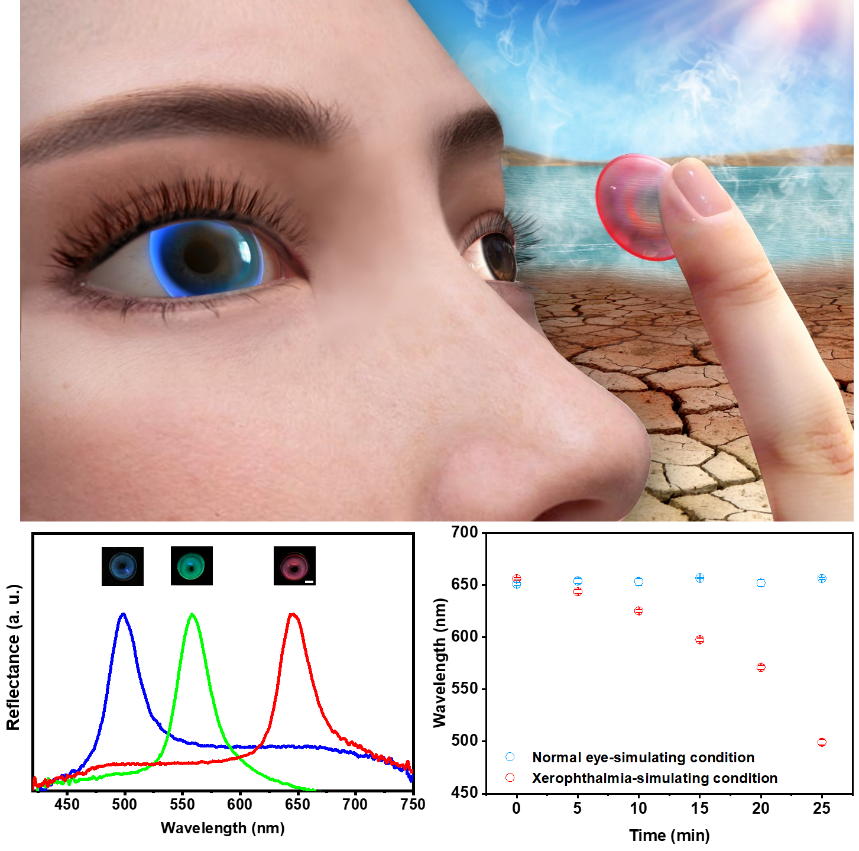Scientists Develop Colored Contact Lens Sensor for Point-Of-Care Ophthalmic Health Monitoring
A specially designed “smart” cosmetic contact lens developed by Shenzhen Institutes of Advanced Technology (SIAT) of the Chinese Academy of Sciences was found to have slowed real-time changes of moisture and pressure by altering colors, which can be potentially used for POC diagnosis of xerophthalmia and high intraocular pressure disease.
The “smart” cosmetic contact lens developed by a research group led by Prof. DU Xuemin, their research direction covers mainlymicro/nano materials, chemical sensors, biosensors and intelligent biomaterials.
Early diagnosis is of great importance for avoiding severe problems in eye, such as exophthalmia (relatively mild symptoms) and glaucoma (may lead to loss of vision), which relies on facile and reliable monitoring of several features with significant pathologic relevance such as the amounts of tears and intraocular pressure.
However, current methods usually require complex procedures and instruments operated by professional staffs, which brings difficulties in point-of-care (POC) ophthalmic health monitoring.
The “smart” cosmetic contact lens introduced periodic nanostructures within the body matrix of the poly (2-hydroxyethyl methacrylate) (PHEMA) hydrogel, resulted in bright and tunable structural colors ranging from red, green to blue. Since there’s no organic dyes or pigments, except for the US Food and Drug Administration (FDA) approved PHEMA hydrogel, in the components, this structurally colored contact lens sensor is made solely from a biocompatible hydrogel, without the addition of any chemical pigments, therefore exhibiting superior biosafety and wearing comfort for wearable applications.
Importantly, the spacings of periodic nanostructures within the PHEMA hydrogels are sensitive to the changes of moistures and pressure, leading to real-time color changes of the “smart” cosmetic contact lens.
"Based on these features, the 'smart' cosmetic contact lens was explored for monitoring xerophthalmia and high intraocular pressure disease. In the normal eye-simulating condition, its color is not changed over time, while its color significant changes from red to blue in the xerophthalmia-simulating condition just over 25 mins. Additionally, linear decrease in the wavelength of the reflectance peak of the “smart” cosmetic contact lens is observed within the pathologic relevant range to human’s intraocular pressure, i.e., 1-4 kPa,” said ZHAO Qilong, first author of the study.
"This study provides a novel and smart wearable device for timely and facile warning the risks of xerophthalmia and high intraocular pressure disease, which will also inspire the design of new generation of wearable devices with colorimetric sensing capabilities for real-time POC monitoring of various human body signs and diseases,” said Prof. DU Xuemin from SIAT.
The results were published in the Journal of Materials Chemistry B, and the research team has obtained a number of invention patents in related technologies.

A schematic illustration and images of the “smart” cosmetic contact lens for point-of-care ophthalmic health monitoring (Image by DU Xuemin)
CONTACT:
ZHANG Xiaomin
Email: xm.zhang@siat.ac.cn
Tel: 86-755-86585299
Download the attachment:Structurally coloured contact lens sensor for point-of-care ophthalmic health monitoring